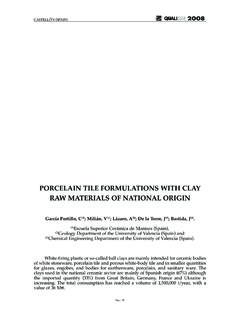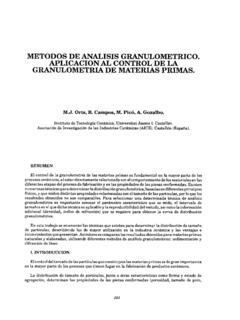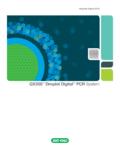Transcription of CERAMIC PIGMENTS FOR DIGITAL DECORATION INKS: AN …
1 CASTELL N (SPAIN)1 CERAMIC PIGMENTS FOR DIGITAL DECORATION inks : AN OVERVIEWM. Dondi, M. Blosi, D. Gardini, C. ZanelliISTEC-CNR, Institute of Science and Technology for Ceramics, Faenza (Italy)ABSTRACTThe field of CERAMIC colorants is one of the most conservative in tile making. Reduction of cost and impact on health and the environment have been the driving force for innovation in pigment manufacturing, where the main technological goals were fast synthesis routes and minimizing hazardous components and additives.
2 The advent of DIGITAL DECORATION is overviewed with its paradigm shift from colorant to ink. The requirements for ink-jet printing are reviewed: rheological properties, surface tension, zeta potential, sedimentation, drop size and shape, kinetics of penetration, particle size, control of electrical and magnetic properties, stability in organic media, improved colorant strength. As conventional PIGMENTS and dyes proved to be unsuitable for DIGITAL DECORATION , colorant manufacturers were forced to upgrade processing (micronizing step for PIGMENTS ) and to become involved in ink design (improving colorant strength for dyes).
3 By this way, different classes of colorants for DIGITAL ink have been developed: organo-metallic complexes, mi-cronized PIGMENTS , colloidal metals, nanopigments and reactive sol precursors for in-situ synthesis. The main challenges for ink manufacturers are still the stability over time (sometimes limited to a few weeks) and the gamut (much narrower than that of conventional CERAMIC colorants). As a matter of fact, typical quadrichromy or hexachromy is still a hard task to be achieved with CERAMIC colorants and tile makers are often choosing unconventional colour sets based on brown shades.
4 This circumstance is revitalizing the industrial interest towards alternative routes for pigment synthesis (chimie douce or bottom-up approach) and technological solutions to improve the colour performance (pigment coating, core-shell structu-res, use of primers and buffers). Physico-chemical properties of inks , which affect the stability over time, are turning critical with increasing diffusion of DIGITAL de-coration. From this standpoint, technologies able to control colloidal suspensions and to design hybrid organic-inorganic composites are rapidly gaining interest and application N (SPAIN)1.
5 INTRODUCTIONThe field of CERAMIC colorants is probably the most conservative in tile ma-king: almost every pigment and dye have been known for decades (Table I). Pig-ments are coloured crystals dispersed in glazes or bodies; they must withstand physical and chemical attack from the liquid phase formed during firing. Dyes are substances that during firing dissolve in the liquid phase; they impart colour by diffusing transition elements into glazes and bodies [1-2]. CERAMIC colorants passed practically unchanged through technological revo-lutions, like development of fast firing [3] or through-body DECORATION of porce-lain stoneware [4] despite their drastic variation of firing schedules (particularly higher temperatures) and composition of CERAMIC matrices (glazes and porcelain stoneware bodies).
6 In pigment manufacturing, innovation has been essentially driven by the pres-sure to reduce cost and impact on health and the environment. The main tech-nological advancements have concerned the introduction of fast synthesis routes, rotary furnaces and roller kilns [5], as well as jet milling [6], to keep manu-facturing costs competitive. In order to fulfil the ever stricter requirements about the environmental impact, the number and amount of hazardous components and additives have been minimized [7-8].This overall trend committed to large-scale production of CERAMIC colorants has been shaken by the advent of DIGITAL DECORATION .
7 Its rapid spread in tile making is bringing about new requisites for performance of colorants that are changing their criteria of design [9]. The aim of this paper is to overview the impact that ink-jet printing has on current situation and prospect of CERAMIC PIGMENTS and dyes. Structure Colour Formula Known since (at least)BindheimiteyellowPb2Sb2O7 Babylonia, 6th century BCOlivineblueCo2 SiO4 Ullmann s Enzyklopaedie der technischen Chemie, 1929 SpinelblueCoAl2O4 Spinelblack(Co,Ni,Fe,Cr,Mn)3O4 Cassiteritepink(Sn,Cr)O2 Corundumgreen(Cr,Al)2O3 UvarovitegreenCa3Cr2Si3O12 MalayaiteburgundyCa(Sn,Cr)SiO5 Greenockiteorange-redCd(S,Se)Stuckert, Farbenzeit.
8 1934 Rutileorange(Ti,Cr,Sb)O2 Harbert, US Patent 1934 Rutiletobacco(Ti,Cr,W)O2 Harbert, US Patent 1941 Zirconyellow(Zr,Pr)SiO4 Seabright, US Patent 1947 Zirconturquoise(Zr,V)(Si,V)O4 ZirconredFe2O3-ZrSiO4 Baddeleyiteyellow(Zr,V)O2 Viehweger, Sprechsaal 1956 Cerianitered(Ce,Pr)O2 Olazcuaga, CR Ac Sci 1986 PerovskiteredY(Al,Cr)O3 Baldi & Dolen, Patent 1995 Table I. Early industrial application of the main CERAMIC N (SPAIN)PhenomenonInk propertyInk requirementNozzle cloggingpigment particle sizediameter <1 mPigment sedimentationZeta potential (electrostatic stabilization)(water-based inks )
9 Ink drippingsurface tension20-45 mN m-1 Ink spreading over the nozzle Ink spreading over the tileInk drop size and shapeviscosity4-40 mPa sInk penetration into the tileInk g cm-3 Corrosion of nozzlespH5 < pH < 10 Pigment dissolutioninsolubility in organic mediavery lowConduction of electricityelectric conductivity[1] >1000 S cm-1[2] <100 S cm-1[1] water-based inks , [2] inks based on organic II. Phenomena possibly occurring during ink-jet printing, related ink chemical and physical properties and ink requirements for DIGITAL FROM COLORANT TO INKThe growing diffusion of ink-jet printing in CERAMIC tile making implies for colorant manufacturers a paradigm shift: the emphasis is forced to move from pigment (or dye) to ink, as a consequence of DIGITAL production constraints [9].
10 In fact, DIGITAL printers impose very strict requirements for inks , which may be hardly controlled and adjusted on the DECORATION line, as it happens with conventional technologies, like screen printing or silicon roller printing. Therefore, colorant ma-nufacturers have to be involved in ink design and preparation: the finished product is no longer a pigment or a dye to be added to the ink formulation by the customer, but rather an engineered ink encompassing colorant, solvent and usually a lot of additives used to keep chemical and physical properties within the window of values acceptable by ink-jet printers [10-12].












